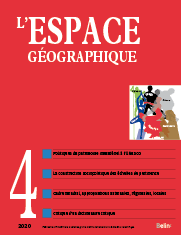

Heritage-making in search of scale. Introduction
First world war funerary and memorial sites as “world” heritage: Resorting to an inconceivable scalar category? (2 fig.)
In recent years, the “global” category has tended to impose itself in the war heritage industry, including the will to insert certain battlefields in the World Heritage List. This article analyses the plurality of scales employed in serial transnational sites applications for Great War funeral and memorial sites. The use of a new scalar category to identify and qualify the value of these serial properties far from undermines references to “national” or “local” levels, and examines the possible fabrication of a “universal” value associated with war sites.
keywords: GREAT TRANSNATIONAL WAR, MEMORY, SERIAL PROPERTY, WORLD HERITAGE
“Let’s get together”: The making of shared heritage between bureaucratization of utopia and utopianization of bureaucracy (1 photo)
This paper tackles the correlation between bureaucracy, ideologies of scale and utopia in the production of “shared heritage” as an incarnation of UNESCO’s ideal of uniting people beyond physical and symbolic borders. UNESCO’s scalar utopia is explored through a focus on “multi-national nominations” to the representative list of intangible cultural heritage. Their political agency is exemplified by the binational bid of Korean wrestling emphasizing the common culture of rival countries. This mechanism is compared to a rhetoric of universality emerging from the debates supporting the inscription of reggae and yoga on the same list. Participant observation carried out at different sites within the intangible cultural heritage global apparatus sheds light on the resourcefulness of heritage officials in the pursuit of ideals of unity: Administrative technologies intended to create representations of heritage as shared are designed and implemented in a process that makes utopia bureaucratic and bureaucracy utopian.
keywords: BUREAUCRACY, INTANGIBLE CULTURAL HERITAGE, SHARED HERITAGE, UNESCO, UTOPIA
Scale f(r)ictions: The political stakes of the inscription of watchmakers know-how of Franco-Swiss Jura region by UNESCO (2 fig.)
What can an intangible cultural heritage (ICH) approach focused on the imagined geographies of stakeholders and social organisations tell us about forms of community belonging? To answer this question, this article examines the case of watchmaking art in Switzerland and France, and particularly the elaboration of the “Craftsmanship of mechanical watchmaking and art mechanics” nomination file for an inscription on the Representative List of the ICH of Humanity officialized in December 2020. The article conceptualises these imagined geographies as “scalar systems” used distinctively by groups and individuals from the watchmaking world, from government administrations and from the social sciences, within both countries, between stakeholders of the two countries, and at the scale of the transboundary region that links them; it then analyses the issues that underpin these geographies.
keywords: COMMUNITY, INTANGIBLE CULTURAL HERITAGE, JURA MOUNTAINS RANGE REGION, SCALAR SYSTEMS, TRANSBOUNDARY PRACTICES, WATCHMAKING ART
Imaginaries and rhetorics of “globality” in UNESCO’s intangible cultural heritage
This paper analyses how cultural practices that are sometimes said to be globalized – yoga, falconry, tango, flamenco, and mountaineering – were promoted and later inscribed on the UNESCO representative List for intangible cultural heritage. It studies the rhetorics and scalar strategies adopted in each application, and more precisely the way the notion of “globality” or “worldwideness” has been claimed or qualified for promoting the inscriptionin arguing the merits of an inscription. It explains why some nominations have been guided by a regionalist or nationalist concern refocus (flamenco, tango, yoga), while some others emphasized the transnational character of the practice and interstate partnerships (mountaineering, falconry). Finally, the article explains how the application process in such cases wields several imaginaries of globality, and the fact that their combination plays a decisive role in the success of an application.
keywords: GLOBALITY, HERITAGE-MAKING, IMAGINARIES, SCALE, UNESCO, WORLDWIDENESS
Book reviews
In this issue of l’Espace géographique, you will find critical reviews of the following books
BRUMANN C. (2021). The Best We Share. Nation, Culture and World-Making in the UNESCO World Heritage Arena. New York: Berghahn, 316 p. (Bernard Debarbieux, université de Genève) ISBN: 978-1-80073-044-1, eISBN: 978-1-80073-045-8
L’espace géographique 3/20![]()
![]() L’espace géographique 1-2/21
L’espace géographique 1-2/21
For subscribe or buy this issue: BELIN
![]() L’Espace géographique: contents
L’Espace géographique: contents
Last modified: October 6, 2021